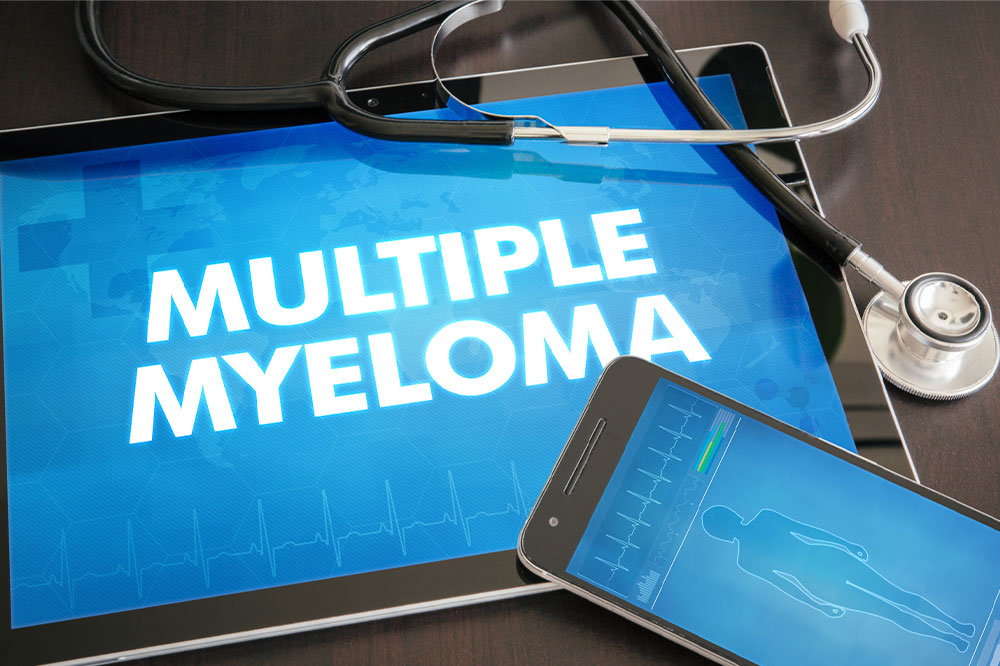14 Signs of Multiple Myeloma to Look Out for

Multiple myeloma is a type of cancer that develops in the plasma cells or the white blood cells (WBCs). Healthy plasma cells help combat infections in the body by forming antibodies, which identify and attack germs. Cancerous plasma cells collect in the bone marrow in people with multiple myeloma, crowding the healthy blood cells. Hence, these malignant cells produce abnormal proteins instead of producing antibodies and negatively impact one’s health.
Signs of multiple myeloma
Weakness or numbness
Typically, multiple myeloma is associated with nerve compression, which can cause numbness in the limbs. Hyperviscosity might result in numbness or weakness in the legs, arms, and face.
Nerve damage
At times, the abnormal proteins generated by the plasma cells are toxic to the nerves. The damage can result in numbness and weakness. It might also trigger a needle-like sensation or peripheral neuropathy. Most people disregard this symptom as routine, but it is important to visit a doctor if the episodes are repeated.
Bone pain
It is another symptom usually experienced by people with multiple myeloma. Abnormal plasma cells grow in the cortical bone and bone marrow, resulting in generalized bone thinning and local bone damage. It is known as osteoporosis, a condition that makes the bones more susceptible to breakage.
The ribs or back are the most prevalent sites of bone pain, which may aggravate at night and during movement. When cancer is present in the spine, the vertebrae (individual bones that compose the spine) collapse. It is known as a compression fracture. In the advanced stages of the condition, one’s health might deteriorate further. If one does not take measures to treat the spinal compression instantly, it might result in permanent paralysis.
High levels of calcium
The body’s calcium levels go into the bloodstream when the bone breaks down. Typically, urine flushes it out, but if one has an excess of it, it might result in hypercalcemia. This might make it challenging for the kidneys to keep up, and one might experience further signs such as:
- Severe constipation
- Excessive thirst
- Loss of appetite
- Confusion
- Weakness
- Drowsiness
- Belly or abdominal pain
- Dehydration
- Kidney problems or kidney failure
- Frequent urination
Thrombocytopenia
In this condition, one does not have enough platelets or cells that aid in blood clotting as the unhealthy plasma cells crowd these platelets. This prevent’s the bone marrow from making sufficient platelets.
Leg swelling
Multiple myeloma directly affects one’s kidneys, preventing them from working effectively. It implies that the body fails to get rid of the excess fluids and salts, resulting in swelling in the legs.
Kidney problems
In the initial stages, the symptoms are unclear, but one can spot the signs of kidney damage in urine or a blood test. When kidneys begin failing, they cannot eliminate excess fluid, salt, and waste products from the body. It can result in symptoms like itching, shortness of breath, and weakness.
Anemia
Multiple myeloma hampers blood cell production in the bone marrow, which can result in a lack of red blood cells in the body. It can be a prevalent side effect of multiple myeloma treatment. People with anemia may experience breathlessness, weakness, and tiredness.
Frequent infections
People with multiple myeloma are susceptible to infections as the condition intervenes with the immune system and impairs the body’s ability to combat illness and infection. Thus, one might get frequent infections that usually last long.
Unusual bleeding
In some patients, the condition might result in unusual bleeding and bruising. It may also lead to heavy periods, bleeding gums, and frequent nosebleeds. This may happen because the cancer cells in the bone marrow curtail platelet formation.
Leukopenia
It is the absence of adequate white blood cells. Leukopenia aggravates one’s susceptibility to infections like pneumonia.
Amyloidosis
This condition is caused when amyloid or abnormal proteins accumulate in the body organs.
Cryoglobulinemia
Multiple myeloma might make the protein in the blood clump together during cold weather. It is known as cryoglobulinemia and might result in weakness, purple spots on the mucous membrane, numbness and pain in the toes and fingers when exposed to cold weather, and joint pain.
Thickened blood
In some patients, the condition results in blood thickening more than usual because of the excess proteins. It is known as hyperviscosity and can result in problems like breathlessness, bleeding from the nose and gums, headaches, and blurry vision.
What causes multiple myeloma?
Healthcare providers and researchers do not know the exact cause of the condition. However, a few potential causes are as follows:
Environmental factors : Studies suggest a potential connection between exposure to chemicals in herbicides, fertilizers, pesticides, or radiation and multiple myeloma.
Genetic mutations
Researchers are examining a link between changing or mutating oncogene (cells that promote growth) and multiple myeloma. Some studies also indicate that people with this condition do not have all parts of certain chromosomes.
Having an inflammatory condition or disease : Inflammatory diseases such as rheumatoid arthritis, type-2 diabetes, and heart disease may lead to multiple myeloma.
Risk factors
Age : Usually, people over 65 are more susceptible to developing this type of cancer.
Gender : Studies suggest that men have a greater risk of getting multiple myeloma than women.
Working in the oil-related sector : People working in oil industries are more likely to develop multiple myeloma.
Radiation exposure : People who undergo radiation therapy for any other cancer treatment might develop multiple myeloma.
Pharma cell disorders : Some pharma cell disorders can aggravate one’s risk of developing multiple myeloma. These include:
- Smoldering myeloma : A precancerous condition affecting the plasma cells, which may later become multiple myeloma.
- Solitary plasmacytoma : A rare condition, it is a single tumor of the plasma cells.
- Monoclonal gammopathy of undetermined significance : It is also a precancerous condition that may advance to multiple myeloma.






